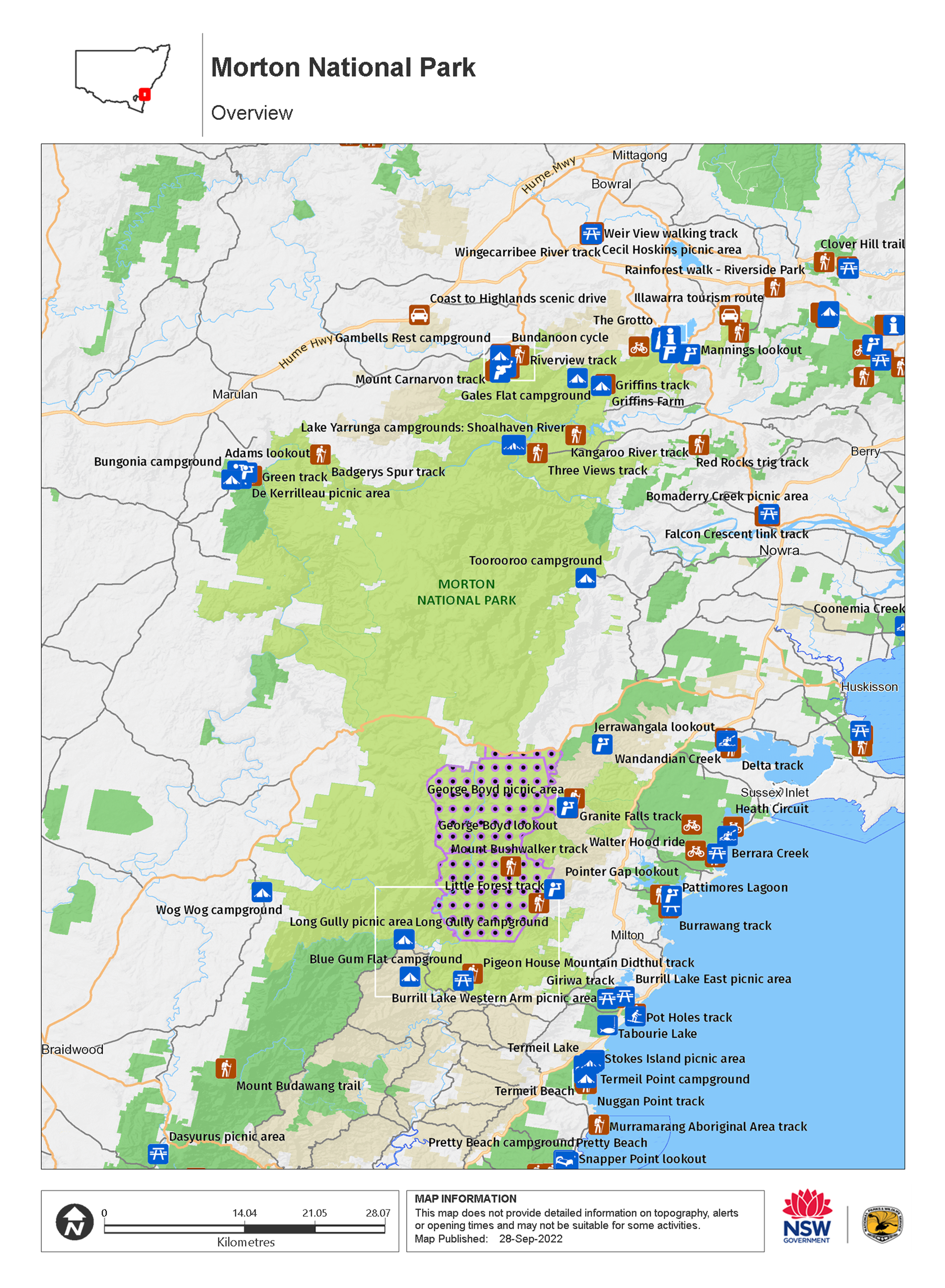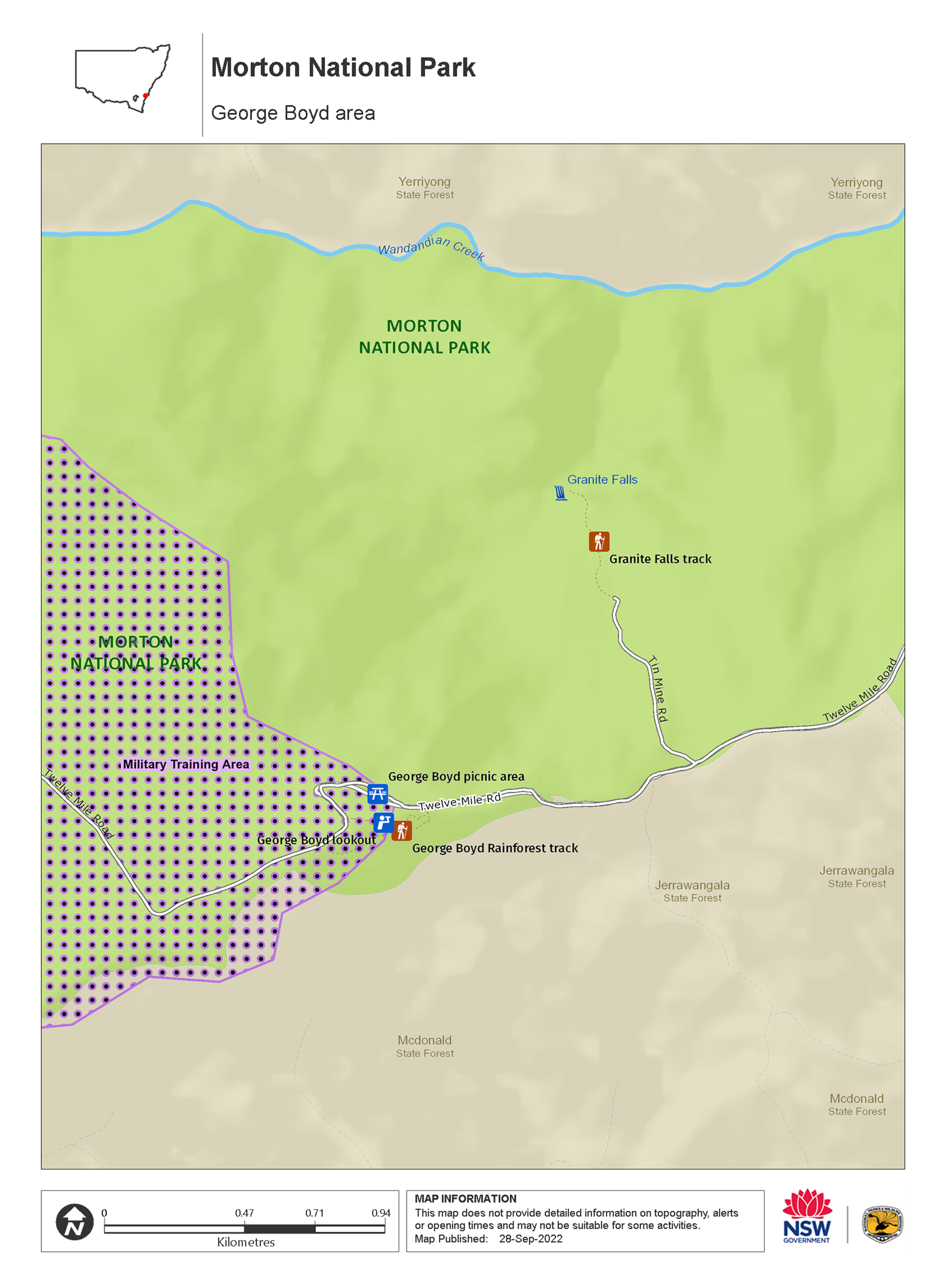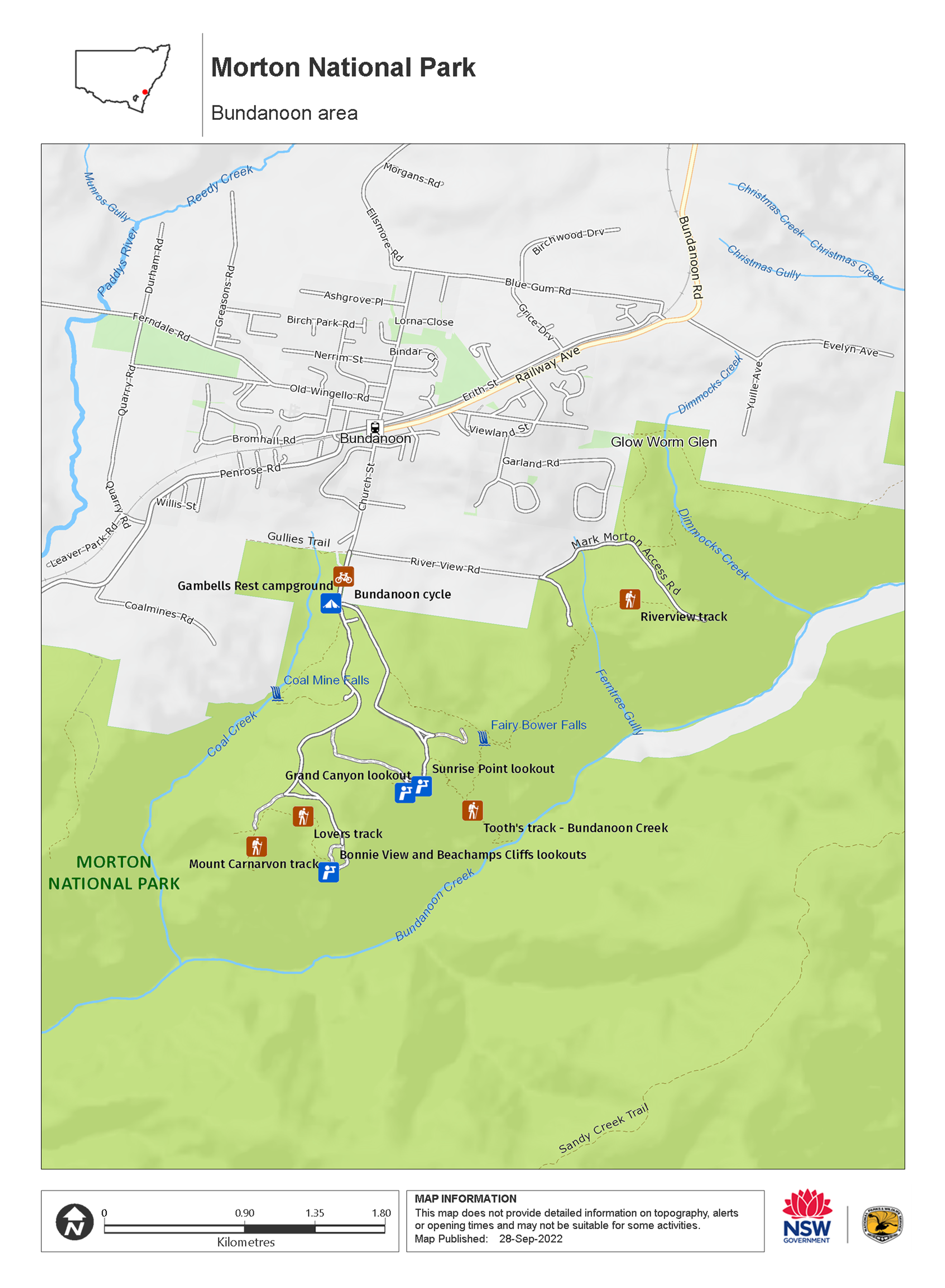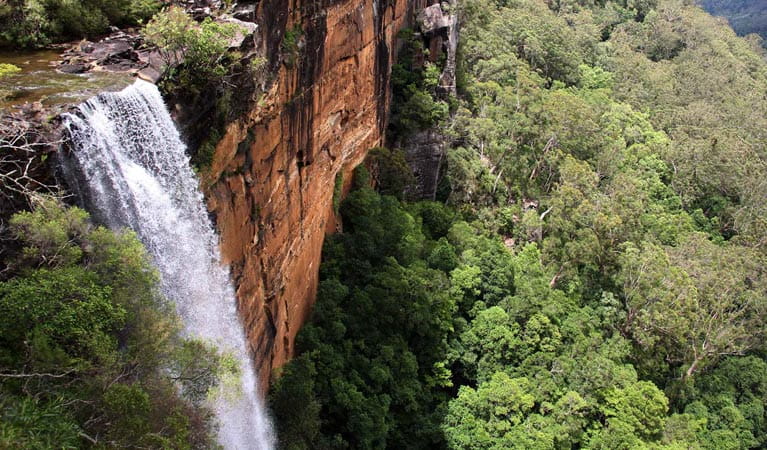Morton National Park
Open, check current alerts
Overview
Easily accessible from Nowra, Morton National Park is great for a daytrip or school excursion. Visit Fitzroy Falls for scenic waterfall views; go mountain biking, walking or enjoy a picnic lunch.
Read more about Morton National Park
Be enthralled by nature on a grand scale at Morton National Park. If the cascading Fitzroy Falls don’t leave you breathless, try the sweeping views from the top of Pigeon House Mountain Didthul.
This enormous park really does have something for everyone; whether you're an experienced bushwalker looking for remote wilderness hiking, a novice mountain biker looking for an easy ride or a keen photographer looking for some scenic waterfalls to capture.
You'll find imposing gorges dissecting the landscape alongside pockets of rainforest that are full of wildlife. There are a number of well equipped picnic areas and numerous informal spots where you can stop for a break to enjoy the view and if you'd like to go camping, head to Gambells Rest campground in the Bundanoon precinct of the park.
The park is easily accessible from Bundanoon, Kangaroo Valley, Nowra and Ulladulla, so it makes for a great day trip or weekend getaway.
Local alerts
For the latest updates on fires, closures and other alerts in this area, see https://www.nationalparks.nsw.gov.au/visit-a-park/parks/morton-national-park/local-alerts
Map

Map

Map

Map

Map

Map legend

Contact
- in the South Coast and Country NSW regions
Morton National Park is always open but may have to close at times due to poor weather or fire danger.
Parts of the south-eastern area of this park were once used for military training and may contain unexploded artillery shells. These areas have restrictions in place for your safety.
-
Park entry fees:
Fitzroy Falls: $4 per vehicle per day. Bundanoon area: $8 per vehicle per day. The park has pay machines - cash and cards accepted.
Buy annual pass. -
-
Fitzroy Falls Visitor Centre
02 4887 8270
Contact hours: 9am to 4pm daily. Closed Christmas Day. - 1301 Nowra Road, Fitzroy Falls NSW 2577
-
Email: FitzroyFalls.VisitorCentre@environment.nsw.gov.au
-
Fitzroy Falls Visitor Centre
-
-
Ulladulla office
02 4454 9500
Contact hours: Monday to Friday, 9am to 4pm. - Lot 9 Blackburn Industrial Estate, 6 Coller Road Ulladulla NSW 2539
-
Email: npws.shoalhaven@environment.nsw.gov.au
-
Ulladulla office
Visitor info
All the practical information you need to know about Morton National Park.
Getting there and parking
Get driving directions
It's half an hour drive from Moss Vale to Fitzroy Falls and Belmore Falls along Nowra Road. Turn north onto Myra Vale Road just east of Fitzroy Falls.
From Nowra, take the Princes Highway to the Southern Highlands via Kangaroo Valley.
From Wollongong it’s about an hour to Fitzroy Falls and Belmore Falls along the Illawarra Highway. Turn south at Robertson onto Belmore Falls Road.
Sites in the eastern and southern part of the park are accessible via the Princes Highway.
Parking Show more
- Blue Gum Flat campground See on map
- Accessible parking at Fitzroy Falls Visitor Centre See on map
- George Boyd lookout See on map
- George Boyd picnic area See on map
- Grand Canyon lookout See on map
- Mannings lookout See on map
- Pointer Gap lookout See on map
- Wog Wog campground See on map
By bike
Check out the Bicycle information for NSW website for more information.
By public transport
For information about public transport options, visit the NSW country transport info website
Best times to visit
There are lots of great things waiting for you in Morton National Park. Here are some of the highlights.
Autumn
Grab an oar and canoe down the Shoalhaven River or the Kangaroo River. Autumn rains create ideal conditions for river paddling, and you'll find good spots for beginners as well as for more experienced paddlers.
Spring
Take the Three Views or Granite Falls walking tracks to see wildflowers in colourful bloom.
Summer
The rainforests of Morton National Park are a great place to escape the summer heat – try the Erith Coal Mine track at Bundanoon or the nearby Fairy Bower Falls walk.
Facilities
Toilets Show more
- Blue Gum Flat campground
- Fitzroy Falls picnic area
- Fitzroy Falls Visitor Centre
- Gambells Rest campground
- George Boyd picnic area
- Griffins Farm campground
- Lake Yarrunga campgrounds: Kangaroo River
- Lake Yarrunga campgrounds: Shoalhaven River
- Pigeon House Mountain Didthul picnic area
- Pointer Gap lookout
- Wog Wog campground
Showers
Picnic tables Show more
- Belmore Falls walking track
- Fitzroy Falls picnic area
- Fitzroy Falls Visitor Centre
- Gambells Rest campground
- George Boyd picnic area
- Grand Canyon lookout
- Mannings lookout
- Pigeon House Mountain Didthul picnic area
- Pointer Gap lookout
Barbecue facilities Show more
Boat ramp
Drinking water Show more
Maps and downloads
Fees and passes
Park entry fees:
Fitzroy Falls: $4 per vehicle per day. Bundanoon area: $8 per vehicle per day. The park has pay machines - cash and cards accepted.
- All Parks Pass - For all parks in NSW (including Kosciuszko NP) $190 (1 year) / $335 (2 years)
- Multi Parks Pass - For all parks in NSW (except Kosciuszko) $65 (1 year) / $115 (2 years)
- Country Parks Pass - For all parks in Country NSW (except Kosciuszko) $45 (1 year) / $75 (2 years)
- Single Country Park Pass - For entry to a single park in country NSW (except Kosciuszko). $22 (1 year) / $40 (2 years)
Annual passes and entry fees (https://www.nationalparks.nsw.gov.au/passes-and-fees)
Prohibited
Pets
Pets and domestic animals (other than certified assistance animals) are not permitted. Find out which regional parks allow dog walking and see the pets in parks policy for more information.
Smoking
NSW national parks are no smoking areas.
Visitor centre
-
Fitzroy Falls Visitor Centre
1301 Nowra Road, Fitzroy Falls NSW 2577 - 9am to 4pm daily. Closed Christmas Day.
- 02 4887 8270
Nearby towns
Bundanoon (1 km)
Bundanoon is the northern gateway to Morton National Park. Follow the well-marked bushwalking trails in one of NSW's largest national parks, admiring waterfalls that plunge into valleys below.
Moss Vale (18 km)
Moss Vale is the rural centre of the Southern Highlands, with its regional livestock saleyards, farmers market and agricultural show. The meandering tree-lined main street and lush gardens make it one of the most picturesque towns in the region.
Kangaroo Valley (47 km)
Kangaroo Valley is a National Trust-listed village nestled between the Cambewarra and Barrengarry mountains. Less than two hours from Canberra and Sydney, Kangaroo Valley is one of the state's hidden gems. With a backdrop of rainforest greens, picturesque mountains, rolling pastures, lush valleys, and the Kangaroo River, Kangaroo Valley offers the perfect escape from the bustle of city life.
Learn more
Morton National Park is a special place. Here are just some of the reasons why:
Teeming with wildlife

This massive park is a sanctuary for all kinds of wildlife. Rainforest and moist eucalypt forest support swamp wallabies, gliders, bush rats and long-nosed potoroos. Birdwatchers will be tickled pink with Morton's residents - satin bowerbirds, green catbirds and lyrebirds call the park home, while eagles and falcons hover overhead. You could be fortunate enough to see an endangered ground parrot in the heath. And, if it really is your lucky day, maybe you'll meet a platypus or long-necked tortoise in one of the rivers.
- Canoes, cool-climate wines and canapés Indulge your taste buds with gourmet food and wine on this enjoyable guided excursion with Wildfest. It’s a great way to reconnect with nature along magical waterways in Morton National Park, near Kangaroo Valley.
- East Rim and Wildflower walking tracks The East Rim and Wildflower walking tracks offer awe inspiring views of the Southern Highlands. Starting from Fitzroy Falls Visitor Centre, wind your way through nature on these connecting tracks.
- Mannings lookout For spectacular cliff-top views over Kangaroo Valley, Mannings lookout offers great birdwatching on a family driving route through the NSW Southern Highlands, in Morton National Park.
- Pigeon House Mountain Didthul picnic area Pigeon House Mountain Didthul picnic area offers basic facilities as well as terrific birdwatching and a walking track up the mountain to a scenic lookout.
- Walking with wombats luxury excursions Even if you're short on time, you can have it all on this tour with Perfect Day Sydney. This unforgettable day out includes a magical bushwalk, visits to waterfalls and other scenic sights, and the chance for wombat encounters during a relaxing twilight dinner.
Rich Aboriginal history

Morton National Park is the traditional Country of the Yuin people. Several hundred Aboriginal sites have been recorded here and there are likely many more. The park's imposing mountains, particularly Didthul, are particularly significant in Aboriginal mythology, as is the majestic Fitzroy Falls. The park's plateau and surrounding country also contain sites of great importance to Aboriginal people, whose occupation of the area dates back over 20,000 years.
- Fitzroy Falls Visitor Centre The award-winning Fitzroy Falls Visitor Centre offers information on the region’s local Aboriginal culture, wildlife and birdwatching, in the Southern Highlands.
- Then and now: Aboriginal culture Then and now: Aboriginal culture is a Stage 3 (Years 5-6) school excursion at Fitzroy Falls in Morton National Park, focusing on HSIE. Through story and creative expression, the life and culture of the local people are shared.
- Then and now: Aboriginal culture Then and now: Aboriginal culture is a Stage 1 (Years 1-2) school excursion in Morton National Park, focusing on HSIE. Through story and creative expression, the life and culture of the local people are shared.
- Then and now: Aboriginal culture Then and now: Aboriginal culture is a Stage 2 (Years 3-4) school excursion at Fitzroy Falls in Morton National Park, focusing on HSIE. Through story and creative expression, the life and culture of the local people are shared.
A rugged beauty

Morton National Park envelops you in its fascinating landscape. Roam through rainforest on the Kangaroo Valley escarpment. Or relax on your picnic blanket, shaded by tall eucalyptus trees - the park has everything from Sydney peppermint to spotted gum and the rare Pigeon House Ash. The park's geological features are equally captivating. Detect different rock types in the cliff face, or find a good vantage point and gaze at the plateau carved with deep gorges. Absorbing the gorges sheer size, coupled with their interesting terraced appearance, can keep you occupied for hours.
- Badgerys Spur walking track Badgerys Spur walking track in Morton National Park offers a steep and challenging hike on the edge of Ettrema Wilderness Area, finishing on the banks of Shoalhaven River.
- Big canoe tour in Morton National Park Grab your friends and take to the waterways of Morton National Park on a guided canoeing tour with Valley Outdoors. You’ll cruise on lakes and rivers in a 9-metre voyageur canoe.
- Castle summit guided overnight hike Conquer the Castle summit on this challenging overnight bushwalk with Epiphany Tours in Morton National Park. You’ll hike through remote landscapes and camp under the stars.
- Granite Falls walking track The easy Granite Falls walking track in Morton National Park, near Nowra, offers scenic waterfall views with springtime wildflowers. Enjoy a picnic by the lookout.
- Self-guided paddling experiences Leave the world behind and paddle away for half, full or multi-day river adventures along breathtaking gorges in Morton National Park with kayaks and canoes supplied by Kangaroo Valley Safaris.
Plants and animals protected in this park
Animals
-

Yellow-tailed black cockatoo (Calyptorhynchus funereus)
The yellow-tailed black cockatoo is one of the largest species of parrot. With dusty-black plumage, they have a yellow tail and cheek patch. They’re easily spotted while bird watching, as they feed on seeds in native forests and pine plantations.
-

Kookaburra (Dacelo novaeguineae)
Of the 2 species of kookaburra found in Australia, the laughing kookaburra is the best-known and the largest of the native kingfishers. With its distinctive riotous call, the laughing kookaburra is commonly heard in open woodlands and forests throughout NSW national parks, making these ideal spots for bird watching.
-

Spotted-tailed quoll (Dasyurus maculatus)
The spotted-tailed quoll is the largest remaining carnivorous marsupial on the Australian mainland. It’s protected as a vulnerable species in NSW.
-

Eastern ground parrot (Pezoporus wallicus wallicus)
The eastern ground parrot is a beautiful, ground-dwelling native bird that lives in low heathland habitat along the NSW North and South coasts and escarpments. It’s listed as a vulnerable species in NSW.
Plants
-

Black sheoak (Allocasuarina littoralis)
The black sheoak is one of a number of casuarina species found across the east coast of Australia and nearby tablelands. Growing to a height of 5-15m, these hardy Australian native plants can survive in poor or sandy soils. The barrel-shaped cone of the black sheoak grows to 10-30mm long.
-

Blueberry ash (Elaeocarpus reticulatus)
The blueberry ash is a rainforest shrub which produces blue olive-shaped berries and spectacular bell-shaped flowers, which often appear on the plant together. It is a tall slender shrub or small tree found in rainforest, tall eucalypt forest and coastal bushland in eastern NSW, south-east Queensland and Victoria.
-

Grass tree (Xanthorrea spp.)
An iconic part of the Australian landscape, the grass tree is widespread across eastern NSW. These Australian native plants have a thick fire-blackened trunk and long spiked leaves. They are found in heath and open forests across eastern NSW. The grass tree grows 1-5m in height and produces striking white-flowered spikes which grow up to 1m long.
Environments in this park
School excursions (4)
- Then and now: Aboriginal culture, Stage 3 (Years 5-6), HSIE
- Then and now: Aboriginal culture, Stage 1 (Years 1-2), HSIE
- Then and now: Aboriginal culture, Stage 2 (Years 3-4), HSIE
- What is a national park?, Stage 2 (Years 3-4), HSIE
What we're doing
Morton National Park has management strategies in place to protect and conserve the values of this park. View the detailed park and fire management documents. Here is just some of the work we’re doing to conserve these values:
Understanding landscapes and geology
Morton National Park ensures the maintenance of special landscapes around the area. Attractions are easily enjoyed by visitors with the implementation of plans to upgrade facilities surrounding particular park attraction areas. NPWS collaborates with volunteers as well as other agencies to ensure the landscape and geological values of the park are preserved.
Preserving biodiversity
Morton National Park National Park embraces programs dedicated to conserving vulnerable, threatened and endangered species within its borders. One example is a program to protect the endangered brush-tailed rock wallaby. Efforts to target threats to such plant, animal and bird species are ongoing in this park, and include pest management and community education activities where required.
Managing weeds, pest animals and other threats
Pests and weeds have a significant impact to the ecosystems within Morton National Park. Reduction of threats, such as foxes, as well as ongoing risk assessments for new and emerging weeds, plays an important role in protecting the biodiversity values of this park.
Developing visitor facilities and experiences
Morton National Park is committed to keeping its visitors safe and informed, and this extends to issues of access and signage. Maintenance of park infrastructure, including walkways, tracks and access points, is ongoing within this park.
Conserving our Aboriginal culture
Morton National Park boasts a proud legacy of Aboriginal culture. Ongoing NPWS projects are in place to survey, monitor and assess the condition of the park’s Aboriginal sites from both a cultural and archaeological perspective. NPWS collaborates with local Aboriginal land councils to facilitate this, and works to ensure sites within the park are appropriately recognised, supported and conserved.
Managing fire
NSW is one of the most bushfire prone areas in the world as a result of our climate, weather systems, vegetation and the rugged terrain. NPWS is committed to maintaining natural and cultural heritage values and minimising the likelihood and impact of bushfires via a strategic program of fire research, fire planning, hazard reduction, highly trained rapid response firefighting crews and community alerts.
General enquiries
- National Parks Contact Centre
- 7am to 7pm daily
- 1300 072 757 (13000 PARKS) for the cost of a local call within Australia excluding mobiles
- parks.info@environment.nsw.gov.au
Contact
- in Morton National Park in the South Coast and Country NSW regions
Morton National Park is always open but may have to close at times due to poor weather or fire danger.
Parts of the south-eastern area of this park were once used for military training and may contain unexploded artillery shells. These areas have restrictions in place for your safety.
-
Park entry fees:
Fitzroy Falls: $4 per vehicle per day. Bundanoon area: $8 per vehicle per day. The park has pay machines - cash and cards accepted.
Buy annual pass -
-
Fitzroy Falls Visitor Centre
02 4887 8270
Contact hours: 9am to 4pm daily. Closed Christmas Day. - 1301 Nowra Road, Fitzroy Falls NSW 2577
-
Email: FitzroyFalls.VisitorCentre@environment.nsw.gov.au
-
Fitzroy Falls Visitor Centre
-
-
Ulladulla office
02 4454 9500
Contact hours: Monday to Friday, 9am to 4pm. - Lot 9 Blackburn Industrial Estate, 6 Coller Road Ulladulla NSW 2539
-
Email: npws.shoalhaven@environment.nsw.gov.au
-
Ulladulla office
In this park:
Things to do (56)
- Aboriginal culture (1)
- Adventure sports (1)
- Birdwatching and wildlife encounters (11)
- Cafes and kiosks (1)
- Canoeing/paddling (3)
- Cycling (3)
- Environmental appreciation/study (1)
- Historic heritage (2)
- Photography (1)
- Picnics and barbecues (7)
- Road trips and car/bus tours (6)
- Sightseeing (42)
- Swimming (1)
- Visitor centres (1)
- Walking (31)
- Waterfalls (18)
- Wildflowers (seasonal) (12)

